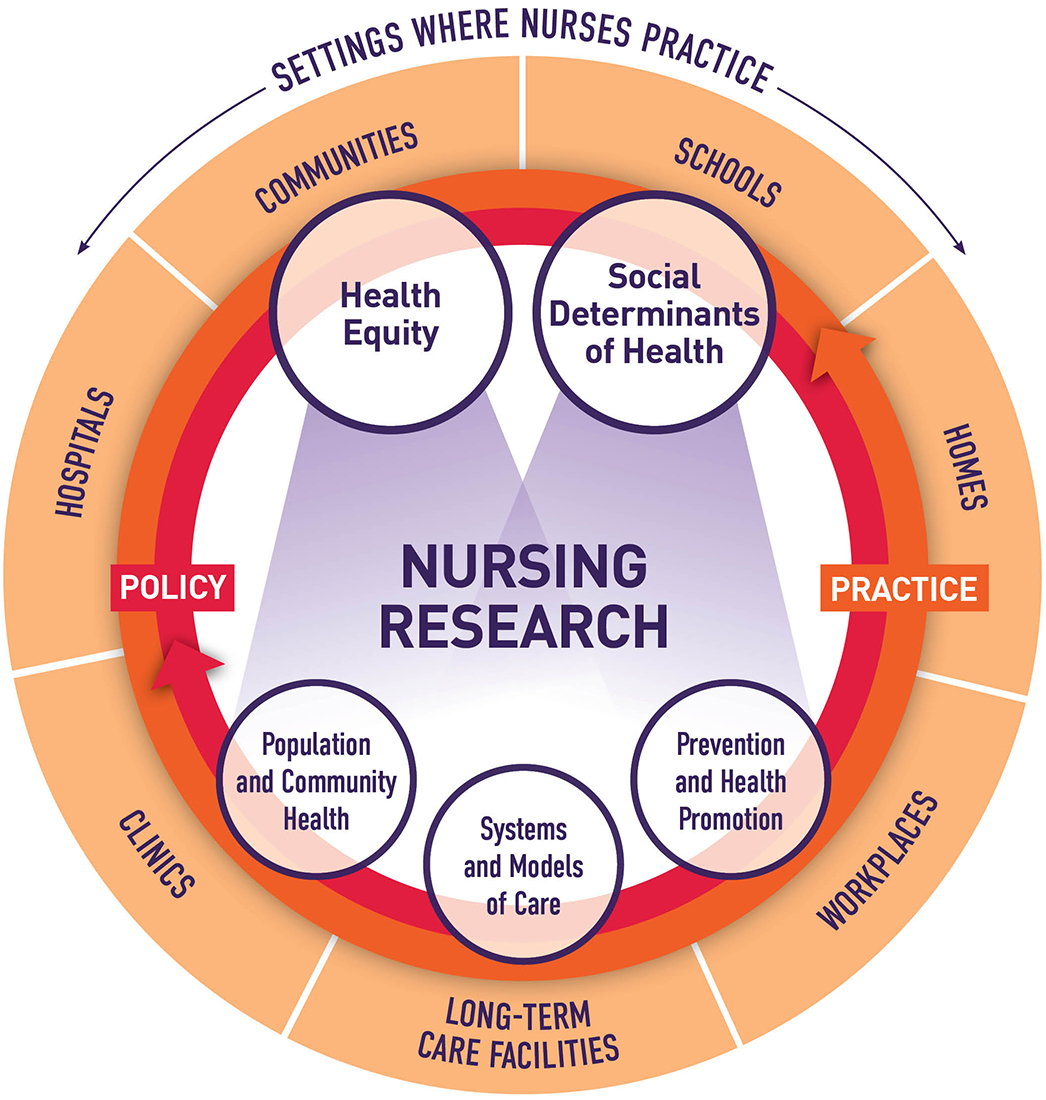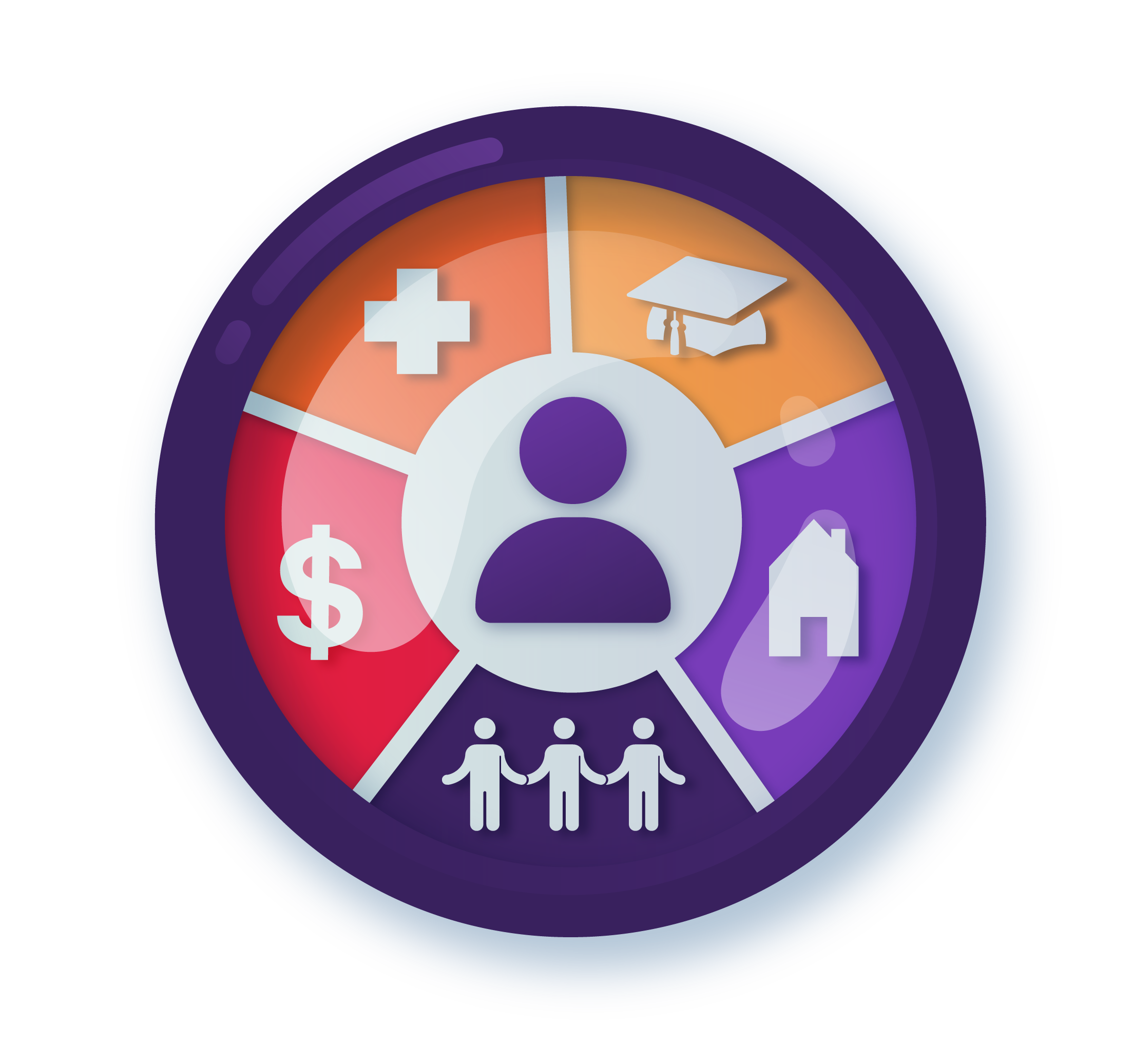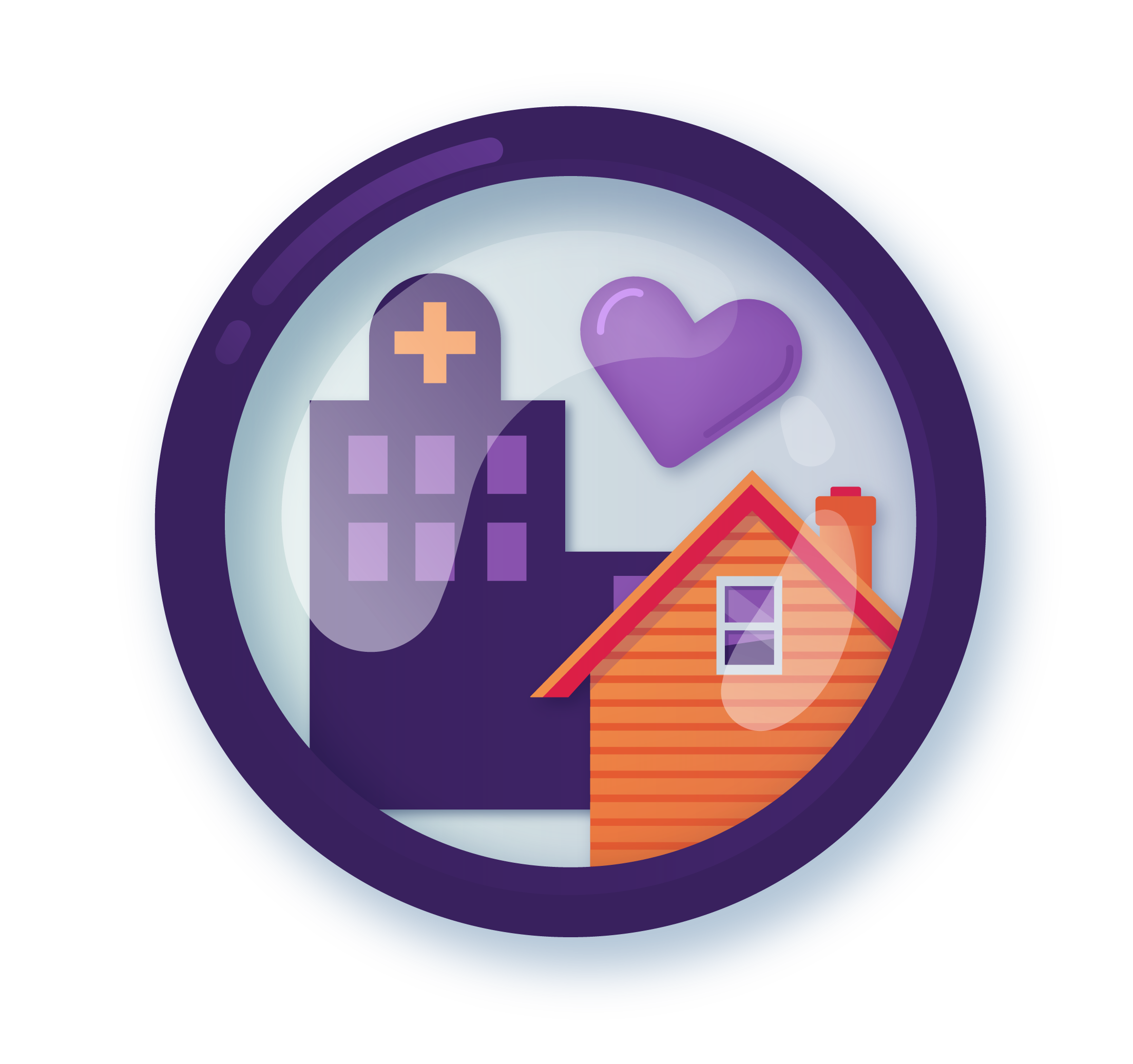NINR developed a research framework that takes advantage of what makes the Institute unique by focusing on a holistic, contextualized approach to optimizing health for all people, rather than on specific diseases, life stages, or research topics. The framework builds on the strengths of nursing research, spans the intersection of health care and public health, and encompasses the clinical and community settings where nurses engage in prevention, treatment, and care—including hospitals and clinics, schools and workplaces, homes and long-term care facilities, justice settings, and throughout the community. The framework encourages research that informs practice and policy, and improves health and quality of life for all people, their families and communities, and the society in which they live.
NINR’s research framework includes guiding principles and research lenses that promote innovative and rigorous multilevel study designs that look upstream, midstream, and downstream to discover solutions to the nation’s most pressing and persistent health challenges.
Figure 1. Nursing Research Through NINR’s Research Lenses

NINR’s guiding principles describe the qualities that investigators should emphasize in all NINR-supported research. In considering awards for funding, the extent to which studies reflect these principles will factor into our decisions.
NINR will prioritize research that:
- tackles today’s pressing health challenges and stimulates discoveries to prepare for, prevent, or address tomorrow’s challenges;
- discovers solutions across clinical, community, and policy settings to optimize health for individuals, families, communities, and populations;
- advances equity by removing structural barriers from research, cultivating diversity in perspectives and ideas, and fostering inclusion and accessibility in designing, conducting, and participating in research; and
- is innovative, develops or applies the most rigorous methods, and has the potential for the greatest impact on health.
NINR identified five complementary and synergistic research lenses that best leverage the strengths of nursing research and promote multilevel approaches, cross-disciplinary and -sectoral collaboration, and community engagement in research. The research lenses are health equity, social determinants of health, population and community health, prevention and health promotion, and systems and models of care. Nursing research is well positioned to address each of these research lenses because of nursing’s expertise in biological, behavioral, social, and public health sciences and long-standing values of social justice, holism, and collaboration.
NINR believes that the application of these lenses to nursing research will lead to scientific discoveries that contend with pressing and persistent health challenges and positively impact practice and policy in the many settings in which nurses work. It is important to note that the lenses are not research topics, but rather perspectives through which to consider the full spectrum of nursing research topics that encompass health and illness within the context of people’s lived experiences. These lenses allow nursing research to examine new topics while also allowing nurse scientists to take a different look at long-standing areas of interest (Table 1).
Table 1. Current NINR Funding Levels for Long-Standing Areas of Interest
| Area of Interest* | Percent of Budget | NIH Rank as a Percent of Budget |
|---|---|---|
| Clinical Research | 78% | 1st |
| Behavioral and Social Sciences Research | 60% | 2nd |
| Prevention | 43% | 3rd |
| Health Disparities | 34% | 2nd |
| Social Determinants of Health | 26% | 3rd |
| Training** | 22% | 2nd |
| Women’s Health | 20% | 4th |
*Funding categories are not mutually exclusive
** National Research Service Awards (Fs/Ts)
Recognizing that definitions for the concepts presented in the research lenses continue to evolve as evidence emerges using cutting-edge methodologies that improve our understanding of them, NINR offers its perspective for each of the research lenses-rather than a definition-for the purpose of providing guidance to investigators.
NINR-supported researchers have the flexibility to apply a single lens or a combination of lenses in their study designs and training programs. NINR encourages researchers to view the health equity and social determinants of health lenses as primary foci through which to consider the population and community health, prevention and health promotion, and systems and models of care lenses (Figure 1).
There are many examples of pressing and persistent health challenges that could be viewed through NINR’s research lenses. Although far from comprehensive, and not intended to guide research proposals, the examples below illustrate just a few of our Nation’s pressing challenges that require urgent solutions:
- People who are Hispanic, Black, and American Indian or Alaska Native are nearly twice as likely to die from COVID-19 as people who are White. [KFF]
- 1 in 5 adults in the United States report experience with discrimination in the health care system and nearly three-quarters of those that experience it report more than one experience. [JAMA]
- In the United States, 6 in 10 adults have one chronic disease, and 4 in 10 have two or more. Chronic diseases are the leading drivers of the nation’s $3.8 trillion in annual health care costs. [CDC]
- People of color face higher rates of diabetes, obesity, stroke, heart disease, and cancer than people who are white. For example, the percentage of U.S. adults who are diagnosed with diabetes is much higher for people who are American Indian or Alaska Native (14.5%), Black (12.1%), or Hispanic/Latino (11.8%) than for those who are White (7.4%). [CDC]
- U.S. women who are pregnant or have recently given birth die by homicide at more than twice the rate of death from bleeding or placental disorders. [Nature]
- Black-majority neighborhoods have a lower life expectancy than the national average by approximately 4.1 years. [Brookings]
- Nearly half of adults with disabilities get no aerobic physical activity, an important protective health behavior to avoid chronic diseases, and are three times more likely to have heart disease, stroke, diabetes, or cancer than adults without disabilities. [CDC]
- Residents of neighborhoods with fewer fresh produce sources and plentiful fast-food restaurants and convenience stores have a higher risk of obesity and diabetes. [HHS]
- Nearly half of adolescents who identify as gay, lesbian, or bisexual seriously considered attempting suicide during COVID-19. [CDC]
- Black individuals are 22% less likely than White individuals to receive any pain medication for similar painful conditions. [PubMed]
- Research-focused doctoral programs in nursing consist of predominately female (89.1%) and White (71.7%) students, and percentages of students who are Black (8.1%) or Hispanic/Latino (9%) are not representative of the U.S. population. [AACN]
 HEALTH EQUITY: Reduce and ultimately eliminate the systemic and structural inequities that place some at an unfair, unjust, and avoidable disadvantage in attaining their full health potential.
HEALTH EQUITY: Reduce and ultimately eliminate the systemic and structural inequities that place some at an unfair, unjust, and avoidable disadvantage in attaining their full health potential.Health equity refers to a state in which every person attains their full health potential. Achieving health equity requires addressing not only the prevalent unjust, unfair, and preventable health disparities but also the structural factors that shape and perpetuate them. Achieving an individual, population, or community's highest level of health often also requires building resources and opportunities, removing obstacles, exploring issues of power, and maximizing and capitalizing on the strengths of those involved.
Research developed using this lens must, at a foundational level, incorporate a focus on a health disparity, as addressing health disparities is an essential step in achieving health equity. This includes but is not limited to science to examine the contributing factors, pathways, and mechanisms underlying health disparities. This also includes intervention research and rigorous evaluation of other approaches (e.g., natural experiments, demonstration projects) for their impact on those disparities. Research that incorporates intersectionality is strongly encouraged.
Of particular interest are studies that both emphasize health disparity and use an equity-centered approach. Two critical components of equity-centered design are the inclusion of structural factors and deep and meaningful engagement with marginalized and minoritized communities or populations. Inclusion of structural factors refers to research that examines or intervenes on structural factors, such as the health impacts of historical and contemporary laws, policies, systems, institutional practices, and social norms that limit access to power, as well as opportunities and resources for marginalized and minoritized groups. The research focus could include removing obstacles and barriers or tackling differences in opportunities and resources. Meaningful engagement of marginalized or minoritized communities ensures that all voices are valued equally. Research partnerships should amplify the voices and influence of affected communities and populations and leverage their strengths.
 SOCIAL DETERMINANTS OF HEALTH: Identify effective approaches to improve health and quality of life by addressing the conditions in which people are born, grow, learn, play, live, and age, and their structural drivers.
SOCIAL DETERMINANTS OF HEALTH: Identify effective approaches to improve health and quality of life by addressing the conditions in which people are born, grow, learn, play, live, and age, and their structural drivers.Social determinants of health (SDOH) research at NINR is guided by the NIH's conceptualization, wherein SDOH are the conditions in which people are born, grow, learn, work, play, live, and age, and the wider set of structural factors shaping the conditions of daily life. Research in this area seeks to protect or improve health by focusing on the conditions of daily life and their structural drivers and explicitly emphasizing factors beyond healthcare that can affect health. This view of SDOH also encompasses factors that can be categorized as commercial and political determinants of health, with the understanding that the language and science around SDOH are constantly evolving.
Research developed using this lens examines causal pathways and mechanisms by which SDOH positively or negatively influences health. It also assesses interventions and other approaches addressing SDOH for their health impacts.
Research developed using this lens may also include studies that focus on social risks and protective factors, the downstream effects of SDOH but not SDOH themselves. Social risks and protective factors are adverse or beneficial individual- or interpersonal-level social and economic circumstances. Social needs or health-related social needs are the specific social risks that an individual or provider prioritizes for assistance in the context of healthcare.
Of particular interest are projects that emphasize action on SDOH, specifically studies that assess interventions or examine how changes in social and structural factors influence health.
 POPULATION AND COMMUNITY HEALTH: Address critical challenges that shape health within and across populations and communities.
POPULATION AND COMMUNITY HEALTH: Address critical challenges that shape health within and across populations and communities.Population health refers to the health and well-being of groups of individuals with one or more shared characteristics and the distribution of outcomes within and across groups. As a subset of population health, community health refers to health and well-being among those connected by place, such as neighborhoods, towns, cities, counties, or tribal jurisdictions. Population and community health research focuses on factors that shape the distribution of health within and across populations/communities, examines pathways/mechanisms through which these factors shape the health of individuals, or examines interventions and other approaches to improve the health of populations/communities.
Research developed using this lens includes etiologic, applied, and translational approaches to identify risk and protective factors, as well as to develop and/or evaluate interventions or changes in policies, systems, and environments. This lens also includes research that aims to promote and develop healthy communities. Although defining a specific target population or community is a required element of research framed using this lens, it is not sufficient; the research must directly address the unique needs of the identified group.
Of particular interest are research that examines the population or community health effects of policy changes; systems thinking approaches to population and community health that examine a phenomenon as a network of interconnected elements that form an integrated whole; interventions that target change in the physical, built, or social environment; and studies deeply informed by and developed in partnership with communities.
 PREVENTION AND HEALTH PROMOTION: Intervene at multiple levels to prevent disease and promote health for all.
PREVENTION AND HEALTH PROMOTION: Intervene at multiple levels to prevent disease and promote health for all.Prevention and health promotion research focuses on reducing the burden of preventable disease and improving and maintaining health while respecting the diversity of human experiences. This research focuses on reducing the risk of disease, injury, and morbidity, improving health, or enhancing well-being. This also includes strength-based approaches that build on assets and resources to protect health.
Research developed using this lens is conducted along a continuum from primordial prevention that targets underlying risks to tertiary prevention that aims to reduce symptoms, severity, and progression. Health promotion includes but is not limited to efforts to facilitate behaviors that reduce risk, improve health, manage disease, and enhance well-being. Equity-minded prevention and health promotion efforts aim to eliminate health inequities by accounting for the social, environmental, behavioral, psychosocial, and biological factors that affect risk. Effective prevention and health promotion efforts must move beyond knowledge transfer and collectively address health-influencing factors at multiple levels, including individual, interpersonal, organizational, community, and societal.
Of particular interest is prevention and health promotion research that investigates interventions or other action-oriented approaches, tests multilevel strategies, and systematically examines how, for whom, under what conditions, and when interventions work.
 SYSTEMS AND MODELS OF CARE: Address the holistic needs of individuals, families, and communities through effective clinical, organizational and policy solutions that optimize care delivery.
SYSTEMS AND MODELS OF CARE: Address the holistic needs of individuals, families, and communities through effective clinical, organizational and policy solutions that optimize care delivery.Systems and models of care research focuses on how healthcare and health services are delivered. It develops effective clinical, organizational, and policy solutions that meet the holistic needs of individuals, families, and communities. This research is meant to improve care across the continuum of a condition, event, or context. This lens includes nurse-led models and those that leverage the expertise of nurses, as well as interprofessional approaches. Within this lens, "systems" is a broad network of connected entities that includes healthcare as well as other systems such as public health, criminal legal, and youth services.
Research developed using this lens may include designing new models or evaluating existing models, comparative-effectiveness studies, pragmatic trials, and implementation science, among other designs. Research traditionally conceptualized as health services research is often aligned with this lens, insofar as it is meant to examine the impact of the organizational structures and the healthcare and public health systems.
Of particular interest are interventions and other approaches that examine or incorporate social determinants of health or health-related social needs, care coordination and continuity of services, community-based care models, multidisciplinary and highly innovative nurse-led team models, public-private partnerships, rigorous interrogation of the healthcare environment related to bias and discrimination, as well as other approaches that incorporate a whole-person and person-centered perspective to healthcare delivery.






